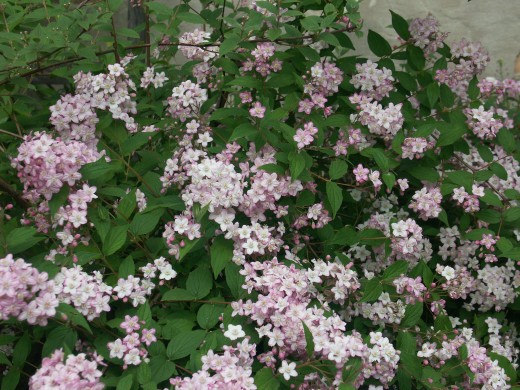Best Blooming Flowers in May.
Armeria
Armeria is my discovery of this year. This perennial is not a very picturesque if planted alone. But it is absolutely up to the place if used in composition as a borderline between other plants, or in rock gardens. There are different types of armerias and this flower can be of different shades. This year I saw armeria in gardens presented at Chelsie Flower Show. It was used by a designer as part of a garden which won a gold medal! The judges of the event definitely have a good taste :-)
Armeria can be described only in the superlative degree. Most species of armeria love sunshine but semishade is also not a problem. It stands well both cold in winter and dry time in summer. After blossoming inflorescence should be cut off.
Armeria can be propagated by seeds, cuttings, and dividing the bush. Seeds are sown in open ground in winter or in spring. For the growth of seedlings it can be sown in a greenhouse in boxes in February - March. Later you can dive seedlings into the ground in a greenhouse. Young plants will bloom on the second year. If the sowing was early, armeria will bloom in autumn of this year. Shrubs are divided every 2-3 years in early spring or fall (more preferably), immediately after flowering. Each cluster can be divided into smaller pieces, which quickly gives roots. The distance between plants should be 15-20 cm.


2. Deutzia
Deutzia is another plant which can be a picturesque decoration of your garden in May. It should be well-known in the United States. The main advantage of Deutzia is a plentiful and prolonged flowering in late spring-early summer. White, pink or lilac-purple flowers are odorless and gathered into small florets.
Most varieties of deutzia are low shrubs (1.2-1.8 m). It can be propagated by seeds and cuttings.
For abundant blooms Deutzia needs a well-fertilized soil of moderate moisture. This shrub can grow in any soil type. Deutzia is an unpretentious shrub. It can tolerate urban conditions, it is resistant to smoke and gas, It is almost not damaged by pests and diseases.
Deutzia needs annual pruning. Withered branches pruned after flowering until the first healthy leaf buds or to the ground. You should occasionally cut unproductive old shoots.
Deutzia is planted in a garden alone or in groups, borders and hedges.
picture of deutzia



3. Iris siberian
I choose Siberian Iris as the next best blossoming flower in May. Unlike bearded irises, this flower will decorate your garden long after the blossoming period. In the wild iris grows in damp places, so in a garden it can be planted near the pond.
Siberian Iris grows well in a partial shade, not in the most fertile soil. It is also able to grow in open sunny location, with a rare watering in a dry summer, but then the height of the plant will be somewhat lower.
In favorable conditions the Siberian irises grow to a height of more than a meter. A blossoming lasts a long time, 4-5 days - this is twice longer than with bearded irises.
The only drawback of Siberian Irises is the lack of odor.
siberian iris in blossom

Flowers blooming in May
4. Bearded iris
Bearded iris is a classical and well -known flower. Their big flowers may be of a huge variety of colors and shapes. A picturesque appearance and its ability to attract attention in every composition made this plant popular among many gardeners. You can plant this flower alone, you can plant them in mixed borders and each time they blossom you enjoy their beauty.
Bearded iris is easy to grow even for beginners. Iris is a light-loving plant. Bearded irises unlike Siberian do not like excessive moisture of the soil, they need a good drainage. Low-lying areas, with stagnated water are not suitable for them. Bearded irises prefer a light soil with a neutral or slightly acid reaction. If your soil contains too much clay components, it is a good idea to add some sand in a proportion 2:1. You may add humus. Iris would like it!
At the end of summer - beginning of autumn it is better to limit watering of bearded irises. A dry soil will stop the growth of new sprouts and helps to endure the winter better.

Phloxes
And finally Phloxes! Phlox subulata will decorate your garden since early spring till late autumn. First - they are absolutely amazing in blossomiung, second, the flowers themselves make a thick green carpet on the ground. I can describe this flower by a proverb "no man is an island". The beauty of phloxes and the force of attraction is in their number. The more you have the better it looks.
Phloxes love direct sunlight and grow well on a light and well drained soil. It is better to cut dry stems after blossoming.
My other nubs about flowers : Best flowers for winter gardening Crocuses Monarda in a garden. Hope you like it!
phloxes in my garden










